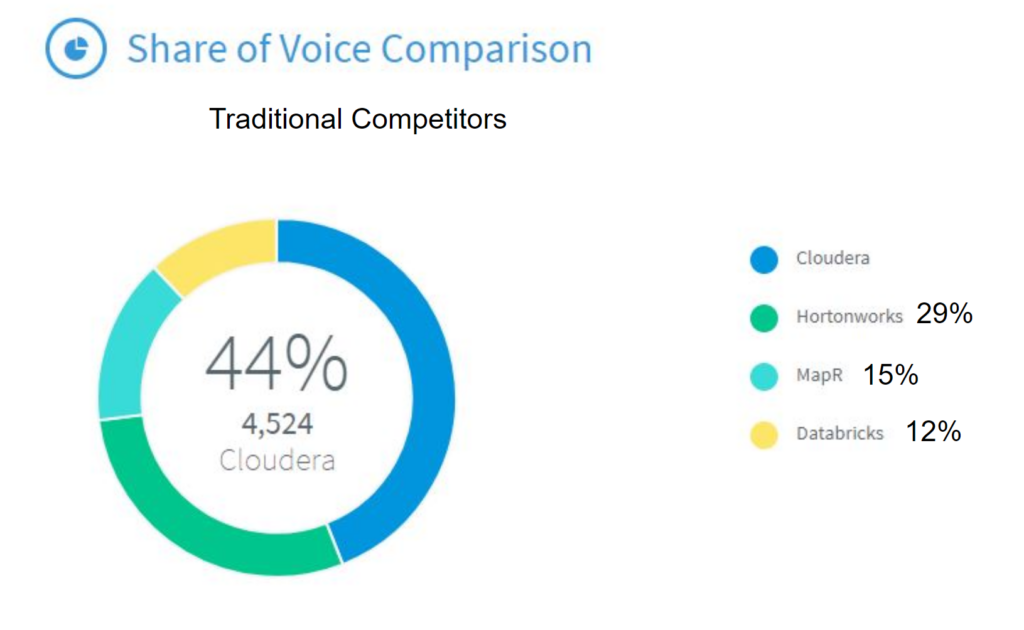A fantastical idea, a powerful pitch, and energetic enthusiasm from all sides of SonicWall stakeholders. Only one task remaining: execution of the over the top Boundless Campaign.
SonicWall came to Bluetext with one main objective: bring their Boundless Cybersecurity campaign to life. As such, the SonicWall team needed creative assistance in bringing the campaign visuals up to par with their brand value. The Bluetext team was asked an age-old question of B2B companies, “How can we make this campaign memorable?”
Especially in the saturated cybersecurity market, it can be challenging to differentiate from strong competitors and help visual abstract brand promises. So the Bluetext team presented a thought-provoking approach to the campaign’s new creative and campaign taglines.
“When cyber threats are limitless, your defenses must be Boundless.” Break free with SonicWall Boundless Cybersecurity.
To communicate and contextualize this message, Bluetext presented a creative direction that would showcase the end-user in a gravity-free surrealist state, which literally breaks free of the constraint of cyber threat. The creative would be scaled across main industry verticals in order to personalize and target advertisements. The idea was over the top, innovative, and ambitious but well-received with client buy-in. Next came the challenge of execution, which was overcome using a custom photoshoot complete with realistic costumes, props, and even a trampoline. In order to achieve the effect of floating in an anti-gravity state, professional ballet dancers were hired to jump on the trampolines. Photographers captured the dancers posing mid-air, then flipped the photo 180°.

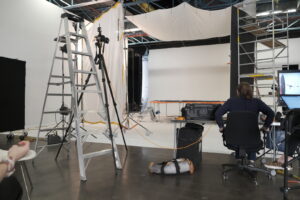


Once the in action shots were captured, the images were edited to remove the backgrounds and impose on industry-specific scenes. Related props were also imposed onto background images to make the scene appear as if person and objects had been magically released from the pull of gravity while the world remains grounded around them.

 At the time of the new Homepage and campaign landing page launch, these static images truly came to life with a subtle parallaxing effect.
At the time of the new Homepage and campaign landing page launch, these static images truly came to life with a subtle parallaxing effect.
To drive users to these newly premiered pages, SonicWall needed eye-catching advertisements that viewers would — no pun intended — gravitate to. Bluetext designed a variety of verticalized static banner ads and further animations to drive page traffic.
Transitioning a company that specializes in a product or service from working in the private sector to one that wins government contracts is no easy task. Negotiations can take months as organizations have to jump through a plethora of hoops to get contracts and budgets approved. Governments also favor companies with whom they’ve worked before or who have had experience operating as a government contractor in the past.
This begs the question — how does a company, perhaps one who doesn’t have as much experience working in the public sector, catch their attention and earn a place at the table? The answer is Content Marketing. You, as a government contractor, can offset your inexperience in the government contract realm via content production. This content can range from blogs to white papers; from videos to infographics; anything and everything that demonstrates your expertise in a given subject and gives you the upper hand over your competition. Most contracting officers, when looking for the right company to reward a contract to, will conduct research, looking at different options with three main criteria in mind: risk mitigation, brand reputation, and visibility.
Getting noticed by contracting officers doesn’t happen overnight, however. Building brand awareness and gaining reputation takes time and effort, and the content you produce must be created with the contracting officer in mind. Knowing who those specific agencies are that you’re targeting and specializing your content for them can set you on the right path from the outset and get you closer to winning those highly coveted government contracts.
Risk Mitigation
When a government agency decides to partner with a new government contractor, the biggest concern they have is mitigating the risk of working with a new partner. Their main goal is to get their contract fulfilled promptly without going over budget. Risk is usually mitigated by choosing to work with a partner they’ve previously worked with, or by working with someone who has a reputation for doing good work on government contracts. If you don’t necessarily have the experience of working in the public sector, you can mitigate as much risk as possible by proving to the client, through content that you produce and they are exposed to, that you have the expertise to handle the work and that you’re able to fulfill the contract and meet the government agency’s demands.
Brand Reputation
Ensuring that your company’s brand is being communicated to your desired audience in the way that you want is crucial when looking to attract government contracts. Although you should not aim to win every contract that comes along, you can set yourself up to showcase your abilities in the shop window using content on your website to prove your worth and show that you do have what it takes to work with government agencies and provide them with the products or services they require. Believe in yourself, your company, and your brand to get the job done, and make it known that you are the go-to company in your field. Create content that showcases your work in the commercial industry and educates readers on how that same success can translate to the public sector.
Visibility
To prove your reputation, you must be visible to your potential clients. You may have the best product or service in the business, but if you don’t have an active presence online, and you’re not showcasing your expertise, it’s not going to get you anywhere. Creating content on your site and sharing it through your social media channels can have a remarkable effect on your brand’s visibility. Sharing news and blog posts to your email subscribers build your brand awareness and attract potential new clients. Do everything and anything to increase the visibility of your brand and drive contracting officers to your site and to the content that you’ve created to show off your products and services.
Bluetext: your leading government contractor branding agency
That’s where Bluetext comes in. With years of experience working with government contractors, Bluetext is your one-stop-shop branding agency for content production. When NetApp, a cloud data services and data management company, had grown its offerings within the market, they turned to Bluetext to partner with and help inform public sector decision makers of the capabilities of their new solutions. Bluetext helped NetApp develop news stories, authored by NetApp experts, to key publications that both educate readers and inform decisions. Through our combined work, we helped position NetApp as a recognized thought leader within the government space.

Content production for experienced government contractors
Bluetext also has a background of working with large, experienced, well-known government contractors. Take our work with ManTech, for example. ManTech is a multibillion dollar public company that provides subcontracted technological services to the government. We partnered with them to produce a series of branded videos for their new website, highlighting their capabilities in one cohesive and powerful story.
Showcasing your abilities to government agencies
Cisco turned to Bluetext when they were looking for help showcasing how their solutions directly address the global networking requirements for the U.S. Federal Government’s integrated intelligence and operations functions. We worked with them to develop a visually appealing storygraphic, which included an interactive wheel to demonstrate the integration and impact of Cisco’s solutions across air, land, and sea to help the government achieve end-to-end mission success.

From veteran-owned SMB to big-time government contractor
One of our more recent projects involved Invictus, a cyber and national security firm, who turned to Bluetext to embark on their next mission: grow from a veteran-owned small business to full-service government contractor. Not only did we update their logo, reimagine their corporate visual identity, and design a modern website, we also created a corporate video that showed their clients exactly who they are, what they stand for, and what they can do for them.
Proving expertise through content
Showing potential end-users proof that your company possesses the grit, determination, and expertise to successfully execute contracts is vital for any company that wants to win government contracts. Expertise is often shown through experience; however, experience can be supplemented with relevant and actionable content on your website. If you can prove that you know the subject matter, agencies will treat you like a veteran government contractor and have faith in you to carry out their contracts. Partnering with a branding firm like Bluetext, who has the experience and expertise in working with government contractors both large and small, can help you achieve your goal of getting your company’s name on the shortlist for that government contract.
To view more of our work with government contractors and how we can partner with you, visit our website today.
B2G public relations is a difficult challenge under the best of circumstances. Both technology companies for which the government is an important vertical and those that are solely focused on government agencies struggle to find customers who are willing or able to participate in media outreach on behalf of their vendor. In many cases, the programs themselves may be confidential or classified, while in other situations, program officials are reluctant to be seen as endorsing a specific contractor.
At Bluetext, we’ve found B2G public relations workarounds for our clients who sell to agencies at the Federal, state, and local level: Talk about the government customer as a hero and innovator rather than pitching a story about the contractor’s solution. While agencies might not want to talk publicly about a contractor’s software or cybersecurity platform, they are much more willing to talk about how their own team members have found innovative ways to solve agency problems.
This was exactly the challenge – and solution – Google’s public sector team was facing when it wanted to broaden its base of federal, state, and local business. Bluetext created a comprehensive “Gov Transformers” program that identified program managers at all levels across the United States who were solving technology and program problems with state-of-the-art technologies, “transforming” the way their agencies were doing business.
Our first step was to design a series of promotional “cards” that could be both physical for trade shows and digital for online marketing campaigns. Each card displayed a provocative statement on the front and included a stylized image of the individual on the back together with a description of the challenge and solution. The stylized image was a visual treatment that rendered photographs into a similar type to attract attention and – more importantly – to “standardize” the images in order to compensate for different cameras and quality of each image.
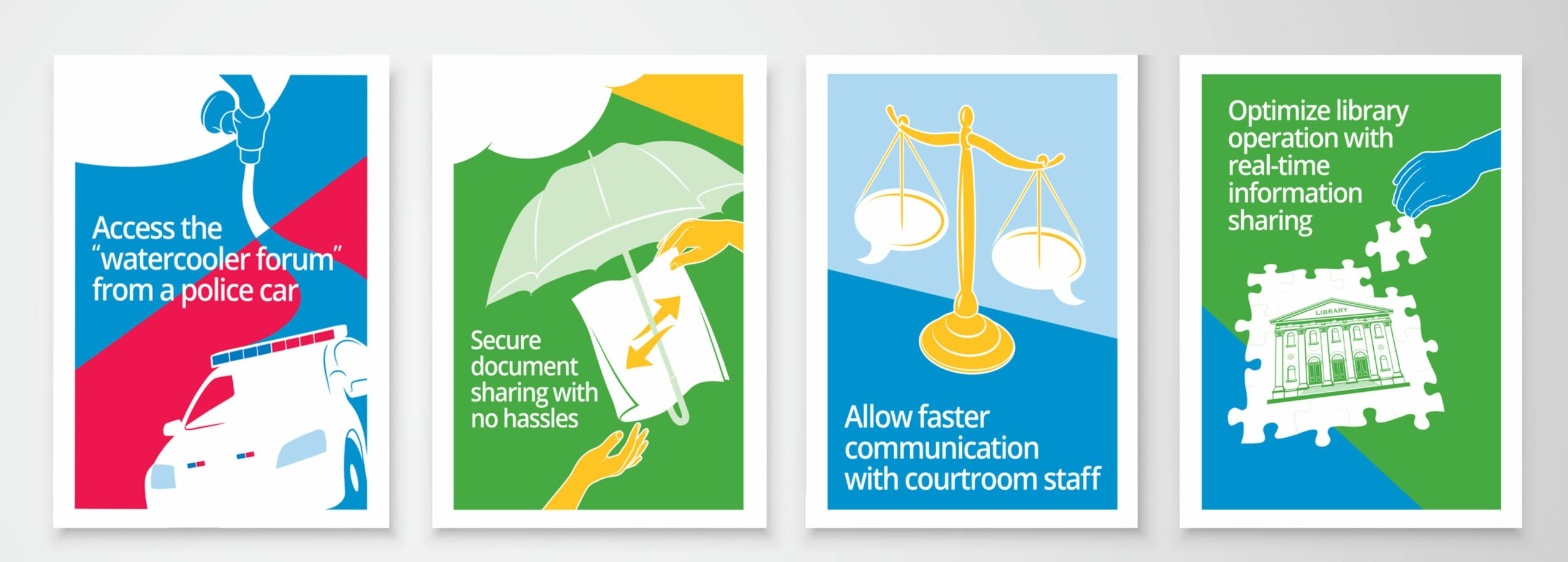
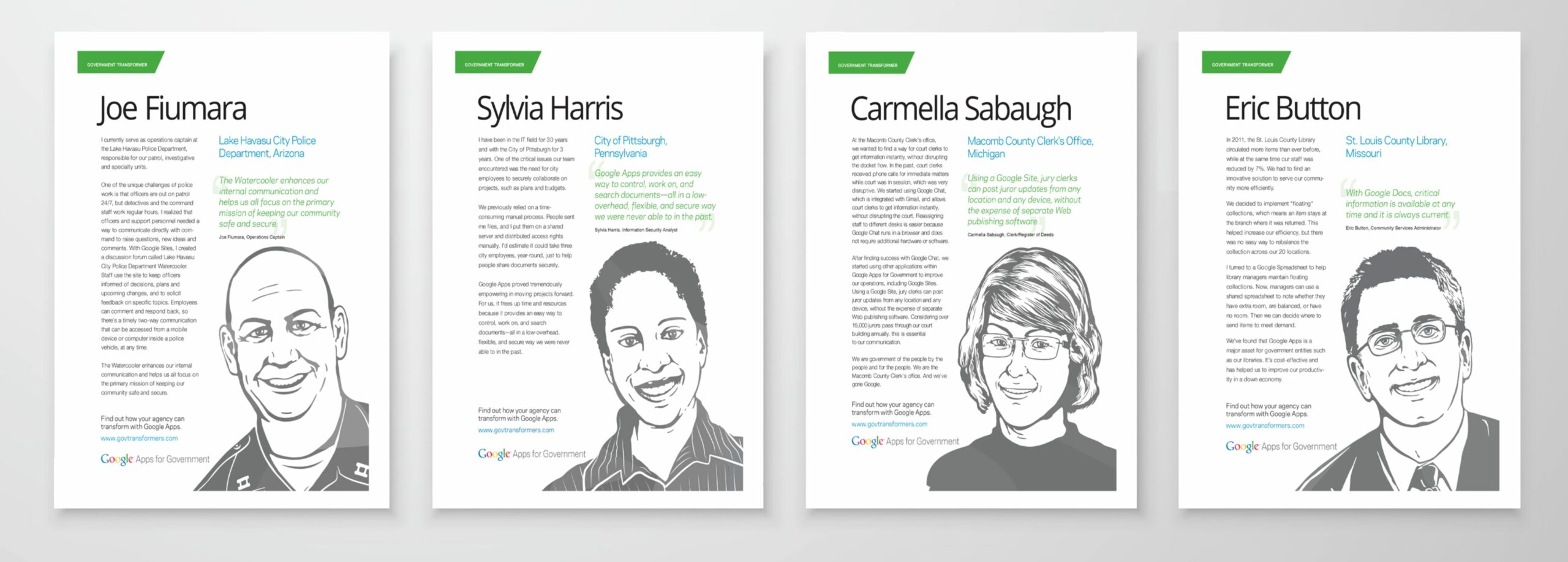
The next step in our approach was to create a microsite repository of customer “hero” stories in the form of a lead-generating campaign with several interactive features. Each case study was tagged by type of solution and location so that searching was easy and intuitive. We sent our professional photographers to capture each individual with a more formal approach and made those images the homepage of the website:
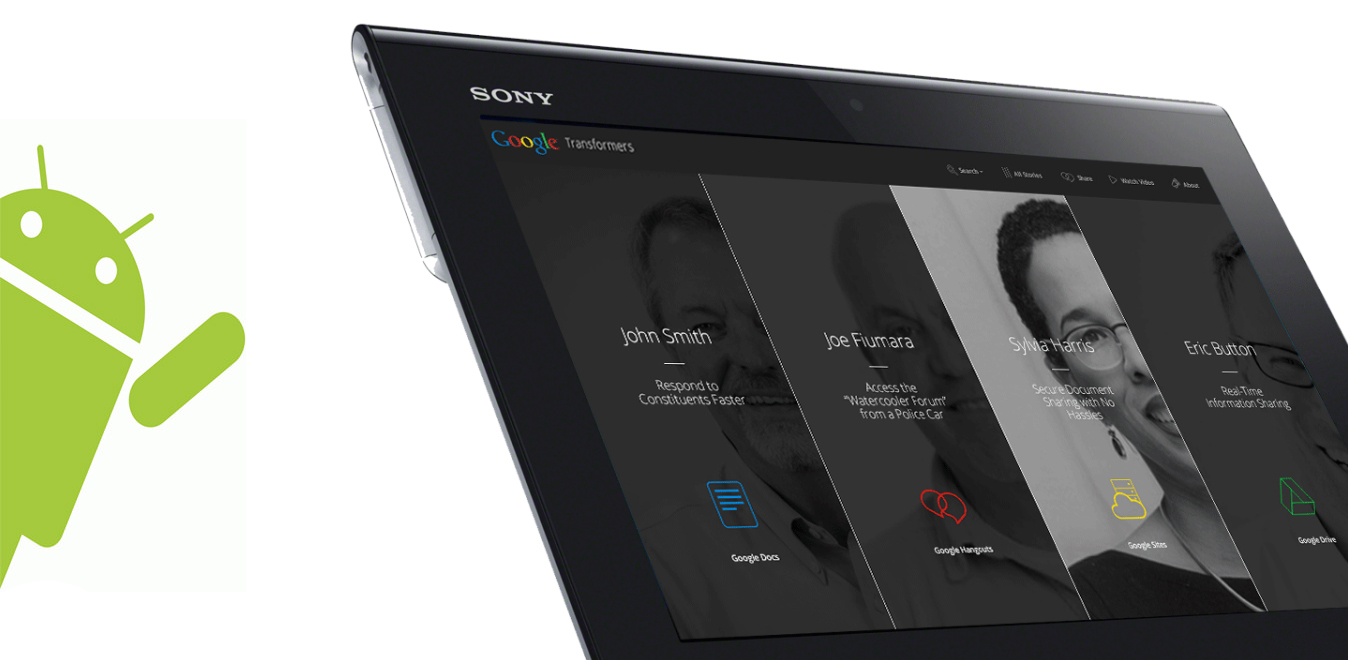
The website was not only used for driving leads among government customers, but it was also pushed out to media as a bank of customer case studies that were packaged together and ready to go. The Gov Transformers campaign achieved several important goals. First, it presented a way to get the Google technology story out without violating any restrictions. Second, it made the government customers feel proud about they had achieved, and gave them the recognition they most often never get. And third, it built up a bank of media-ready customer case studies to power B2G public relations activities.
Learn how Bluetext can help you leverage your B2G Public Relations Program.
Government marketing, whether to the federal government or to state and local agencies, poses a whole set of challenges for brands and organizations not familiar with the government sector.
One of the immediate and most apparent challenges is that the customers of a government contractor are wide-ranging and not easily defined, including Federal, state and local decision-makers responsible for purchasing technology products and services. It’s a discrete set of decision-makers – with job titles ranging from CIOs and CTOs to program managers, IT managers and procurement officers – that offer limited channels through which they can be reached. These government customers have firm sets of rules about how they can interact with contractors that make marketing even that much more challenging.
Government customers have mission requirements and set budgets, so the traditional return-on-investment messaging that works well in the commercial enterprise space may not resonate at all with government agencies. Buying cycles are long, procurement requirements extensive, and budgeting is uneven. But the rewards can be great, with a steady stream of revenue lasting years. That’s what makes government marketing both challenging and rewarding when it is successful.
It is these challenges that have led us to issue the following guidance for navigating this often bureaucratic and rarely straightforward environment with tips for marketing to government entities. Here are Bluetext’s top tips for reaching this audience:
Focus on agency needs, not yourself
This is a well-founded marketing principle, but particularly in the government contracting sphere. It is critical that marketers focus on the issues that government agencies face rather than trying to impress potential customers with their own solutions. This means identifying an agency’s particular challenges and crafting your communications to let the government stakeholders know you understand their issues and how you can help solve them.
Highlight previous successes across industries
While demonstrating your fluency in the public sector to a potential customer is critical in winning any government contract, do not be afraid to illustrate successes that are not government-specific. Bringing new and diverse ideas to the government landscape is a big selling point for these customers, as they look to effectively achieve their missions in new and creative ways.
Reach decision makers through compelling digital experiences
Many government decision-makers crave information that stands out in a world of monotonous white papers and unfounded promises of “unprecedented innovation.” We recommend investing in government-focused micro-sites or landing pages with messaging that appeals to the government customers rather than the commercial audience.
Identify specific contracts and targets
Micro-targeting your marketing tactics to specific government verticals, agencies or even decision-makers can make the difference in winning a potential contract. By tailoring your messaging and problem identification to the agency that is soliciting bids, your proposal will recognize the user needs and therefore become increasingly attractive to the buyer.
Government marketing is unlike any other in terms of identifying audiences and influencers, in addition to the lengthy timeline of buying cycles from initial engagement to execution. However if properly packaged, the benefits of winning what are often multi-million dollar contracts can provide contractors years of monetary security as well as the opportunity to assist in solving the nation’s toughest challenges. But it takes the right marketing – and messaging – to reach the government audience.
Learn how Bluetext can help you make the most of your government marketing strategy.
If you’re a brand that sells and markets to the Federal agencies, the floodgates are about to open. Because of the Appropriations bill that was signed into law earlier this year, Federal agencies have $140 billion more than they thought they would before the legislation was agreed to. That’s funding that agencies need to spend before September 30th, the end of the Federal fiscal year. That’s an additional $80 billion for defense and $63 billion for civilian agencies. Those funds are “use-it-or-lose-it”- whatever they don’t spend goes back to the Treasury.
As a result, as Professional Services Council (the trade association that represents Federal contractors) President David Berteau recently told NextGov.com, “(i)f agencies are going to spend the extra money in fiscal 2018, it’s going to have to be at a much higher percentage in the fourth quarter than it has been historically.”
According to NextGov, “only two of the 10 largest federal agencies have managed to spend 70 percent of their projected discretionary budgets by the beginning of the fourth quarter.” Analysts believe the Federal market will see a mad scramble by procurement officials to spend as much on contracts as possible.
This influx of money is both an opportunity and a challenge for companies that see the Federal marketplace as a key vertical market. The opportunity is to present their solutions that can help solve agency problems and help government executives meet their mission requirements and make some key sales before the end of the year.
The challenge is finding the right marketing mix and messaging to get in front of government decision-makers quickly, before the fiscal clock runs out. Here are our recommendations for getting your brand message out to Federal agencies before the end-of-year deadline:
- Federalize the Message. Remember, Federal officials think differently – and react differently – than commercial clients. Because agencies have fixed budgets, ROI (return on investment) is less important. Government officials have mission requirements to meet and want solutions that will achieve those.
- Fit In. Government officials don’t want to see campaigns that aren’t relevant to their needs. Nor do they react to campaigns that don’t look like them. Don’t simply recycle commercial marketing materials – develop new campaigns that look and feel like government solutions.
- Speak Directly to Government Executives. Create a government-targeted landing page that is easy for them to find on your home page. Otherwise, they won’t spend much time hunting around hoping to find marketing materials that talk about their challenges and mission requirements.
- Market to the Whole Audience. It’s easy to think that there are only a handful of Federal officials involved in purchasing decisions. While that might technically be true for the final decision, there are lots of people involved throughout the process. These include top officials who set the policy and goals, program directors who have to implement those policies, project managers who run the actual programs, researchers who might be tasked with exploring options and evaluating choices, and procurement officials who make sure the entire process is followed to the exact letters of the Federal Acquisition Regulations. Make sure your marketing appeals to every step of the process, and every part of the sales funnel.
Need Help Marketing to the Federal Government? Bluetext Can Help.
The Federal government Buying Season is right around the corner. That means that any company that has the technology to help government agencies meet their mission requirements needs to start getting in front of those buyers quickly. The Federal Buying Season begins in August and runs through September as agency procurement officers will make their final selections to meet end-of-year spending requirements. With the government, allocated funds are often “use-it-or-lose-it,’ meaning they won’t carry on through the next fiscal year. Anything unspent becomes out-of-reach.
For government contractors and global brands who consider the agencies a key vertical, putting in place a comprehensive marketing campaign to reach these decision makers starts now. As we pointed out in our previous post, government agencies respond differently than commercial markets. For their Buying Season, they have mission requirements to meet and are looking for the best solutions that will help them do that. That’s why a marketing campaign needs to speak their language and not simply rely on the same campaigns targeted to the commercial sector.
Here are some of the key elements to consider when designing your Federal Buying Season marketing campaign:
- Start with Messaging. As we noted in our previous post, messaging targeted towards the needs of the government buyer is critical. Make sure that messaging talks to their pain points, their mission requirements, and the past experience you have in the market. Those are the three top components that this audience needs to see.
- The Creative Needs to Match the Market. Cutesy, humorous, out-of-the-box campaigns are ok, but within limits. Stay away from the controversial, but adding a little humor can be effective. We recently did a campaign for Intel that included a guy wearing pajamas on the bottom with a suit on top to demonstrate how its technology helps Federal telecommuters. It was clever, cute, and got people thinking while keeping far away from anything offensive.
- Go Directly After the Market. Programmatic campaigns, relying on sophisticated email workflows and paid banner and social media can be effective for driving leads if done in a way reaches those audiences in an intelligent way. Bluetext has had significant, measurable success with well-constructed campaigns targeted at government decision-makers and buyers.
- Coverage in Government Publications Gives Air Cover. A strong media relations component of the campaign can provide thought leadership, wide exposure, and air cover for the sales team. Many government tech trades are happy to publish submitted bylines from industry experts provided that they explore market needs and trends, and are not simply marketing pieces disguised as a news article.
- Drive Time is Prime Time. In the D.C. region – the home to most of the nation’s Federal executives – commuting is a fact of life. That means a captive audience twice a day every day during morning and evening rush hours. We are big believers in radio spots as well as broadcast interviews to reach this audience when they are most receptive.
- Leverage All of Your Company Assets. Every company has a number of Members of Congress that represent their employees. Turn these legislators into advocates for your brand. They can help open doors across the government.
Learn how Bluetext can help your brand with a successful Buying Season campaign.
Technology and defense companies who include the public sector as an important market view mid-summer as their time to get busy. For marketing to the Federal government, whose fiscal year begins October 1, we call this the “buying season,” because in August and September agency procurement officers will make their final selections to meet end-of-year requirements. With the government, allocated funds are often “use-it-or-lose-it,’ meaning they won’t carry on through the next fiscal year. Anything unspent becomes out-of-reach.
That’s why a sound marketing strategy tailored specifically to the Federal agencies is so important starting after the July 4th holiday. Giving program managers and those in procurement your best effort to select your products or solutions for their purchasing decisions is essential during these next several months. Here are our top tips for marketing to the Federal agencies during the Buying Season:
- Federalize the Message. Big brands who sell to many different sectors often don’t have the in-house knowledge or expertise to deliver a message to Federal agencies that will resonate with their decision-makers, instead simply repurposing marketing and messaging developed for the commercial markets. Big mistake. Federal officials think differently – and react differently – than commercial clients. Because agencies have fixed budgets, ROI (return on investment) is less important. Yes, budgets can be tight and the best value is important. But that’s a little different than ROI. Government officials have mission requirements to meet and want solutions that will achieve those. Telling them how your product will do that will have a far greater impact than how much money they can save.
- Look Like You Belong. Government officials don’t want to see campaigns that aren’t relevant to their needs. Nor do they react to campaigns that don’t look like them. My favorite mistake that I see all the time is campaigns that use stock images of executives in ultra-modern glass office high-rises. That’s not what government offices look like, and it’s hard to see the connection.
- Make Them Feel Like They Belong. Create a government-targeted landing page that is easy for them to find on your home page. Otherwise, they won’t spend much time hunting around hoping to find marketing materials that talk about their challenges and mission requirements. Use images and color palettes that fit in but also leverage accent colors to stand out. But… give the Feds some credit. They won’t jump at a jet fighter unless there is something about that jet that means something to them. Find the right images, not just ones that you think look patriotic.
- It’s a Big Audience With Lots of Input. It’s easy to think that there are only a handful of Federal officials involved in purchasing decisions. While that might technically be true for the final decision, there are lots of people involved throughout the process. These include top officials who set the policy and goals, program directors who have to implement those policies, project managers who run the actual programs, researchers who might be tasked with exploring options and evaluating choices, and procurement officials who make sure the entire process is followed to the exact letters of the Federal Acquisition Regulations (the voluminous procurement Bible that includes all of the complicated purchasing rules). Make sure your marketing appeals to every step of the process, and every part of the sales funnel.
Need Help Marketing to the Federal Government? Bluetext Can Help.
What’s in a name? Perception.
For federal contractors, your brand is likely delivering an undersized impression. Find out how we help GovCon stand out in D.C. and play a full-sized federal marketing game in a series brought to you by Bluetext & Baird.
Is your brand name down-sizing your federal market presence?

Your company’s name is its ultimate first impression.
As it turns out, who you say you say a lot about who people think you are.
After all, which brand is more intriguing? Aegis Solutions, a company with an arcane, hard-to-spell or pronounce name or Blue Halo? A slightly dated Quantitech or Axient?
In the competitive pool of hundreds of thousands of federal contractors, your name is your first opportunity to stand out from the crowd. Early on, it’s an opportunity most companies miss, settling for a bland description of the company or an assortment of initials.
They’re conventions so familiar, they simply make your business feel smaller than it is. If you have a name like any other business, you’ll be perceived like any other business.
And while brands themselves do not win or lose work, or attract investment or employees, they certainly make all three easier or harder.
Why You Should Consider Rebranding
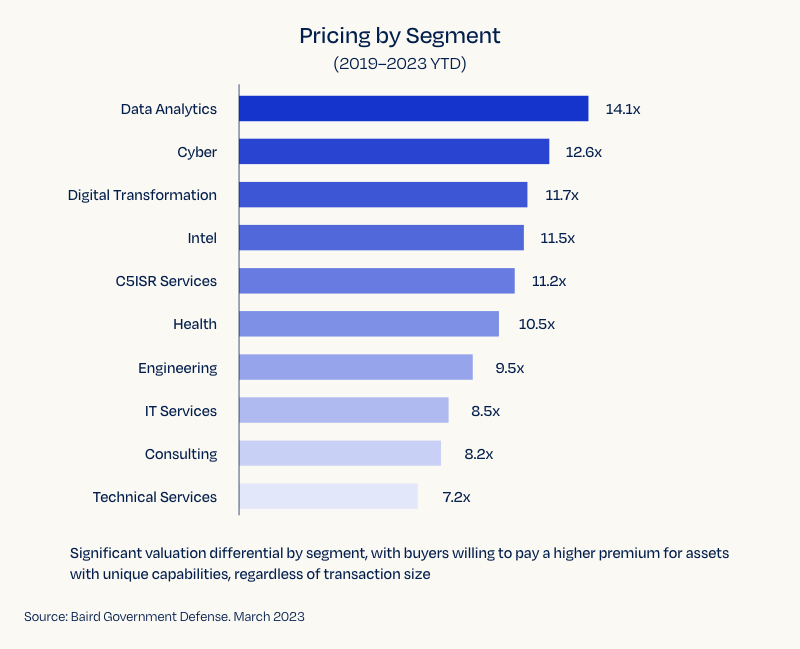
A corporate brand is the professional veneer that creates interest, conveys excitement, and sets you apart as something different, something special. As a growing company, it is among the best investments you can make for brand perception.
It lets you play bigger.
Brand to be the company you want. The names that are initialisms, descriptions, or dated names (say, as a general rule, anything with ‘Net’ as a suffix or ‘e’ as a prefix.) make companies seem like an also-ran. They generate less brand equity as the names themselves are simply forgettable. Any three letters will mostly sound like any other. An IT Solutions Company and an Agile Technologies Incorporated do little to stand out from the thousands of other companies selling a concept as broad as “IT” or who have agility in their win themes.
Break free from the convention. What sounds bigger? Integrity Applications Incorporated or Centauri?
It sets a feel for your company like nothing else.
Bland descriptions and initialisms simply create the stuffy feel of an also-ran federal contractor, of rows of dingy cubicles and coffee-stained cost volumes. Bold names start your brand story with the feeling you choose. Be bold and expeditionary like TorchLight or approachable and expert like Tria. Brand for excellence with Stellant. Lead the feeling you want to convey, the sense of what it’s like to work with you, not a description of who you are.
Employees, customers, and teammates all make snap decisions.
As a federal contractor, you are one of many. And while a brand itself may never win or lose your business, it will help your impression and inclusion into downselects. It’s not just customers, either. It’s the teammates who will be intrigued by your brand story, the candidates who will have their corporate name as a part of their identity, and the full ecosystem of your programs who will see it on lanyards, PowerPoints, and desk toys. Your brand may be forgotten if you do it wrong, but it will never be anonymous. Work with a name that starts your brand conversation on your terms.
How to Choose a Brand Name
With the size of the competitive landscape, choosing a brand name is never as simple as picking a word you like. Which is fine. Competition forces us to think harder, to find more compelling ways into our brand story.
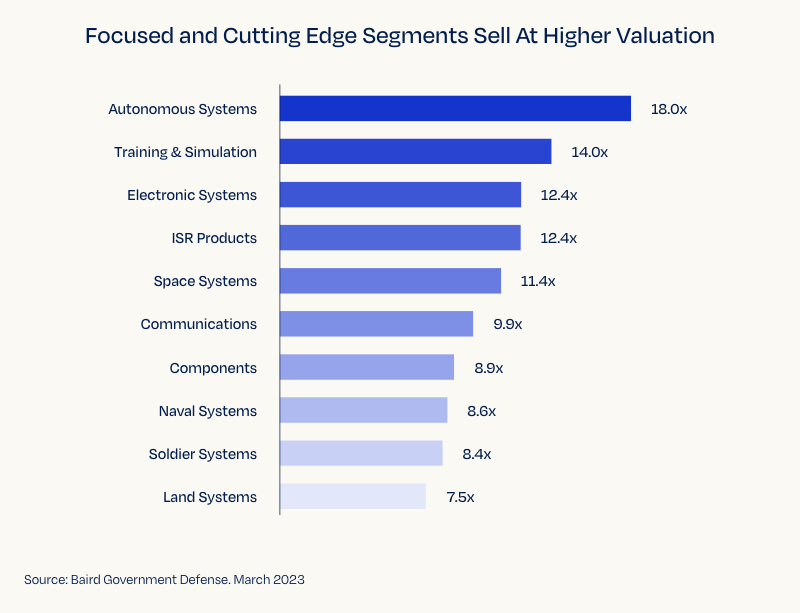
Focused sells in branding too. Pick a name that leads into your brand story and doesn’t obscure your high value work.
Pick a Name That Intrigues
Above all, start with a name that draws an eyebrow raise. Maybe it’s a creative spelling or a combination of two words that aren’t typically used together. Perhaps it’s a word that borrows on a literary allusion or combines roots from Greek or Latin to create a new word with a good brand story. Whatever you choose, be sure it catches your attention. As an exercise, take your potential name and put it in a list of awardees for a recent ID/IQ. See if catches your eye.
Pick a Name That Leads Into Your Brand Story
But don’t tell your full brand story. Limiting yourself by capability or even category can cause problems down the road. Moreover, it can be marketing thought-ender. As marketers, we thrive on the tension created by wanting to know the rest of the story. Pick a name that begins to tell the story but doesn’t complete the idea. Blue Halo tells a story that relates to its protective capabilities in space and air.
After all, marketing is a practice of creating demand, not providing all the answers.
Spelling or Pronunciation: Choose At Least One
While the largest federal contractor in existence breaks this one, as a general rule, get creative, not complex. Be sure your name is either easy to pronounce when you see it or easy to spell when you hear it. Otherwise, you’re asking a lot of those you want to reach … and you. And if we opt for creative spelling at Bluetext, we stick to a one-change limit per brand name.
Avoid Dated or Extraneous Additions
Brand names, like fashion and music, are constantly changing. Companies now with -Net extensions sound like remnants of the late 90s. We’ve avoided Cyber in names as it is likely headed for a similar fate as the practice of “cybersecurity” is just as wide as “information technology” is now. Extraneous modifiers (Services, solutions, group, or the most bothersome, Incorporated), which often are added to appease the trademark lawyers, just ask potential customers and employees to remember more to build brand equity. Focus on your brand name as much as possible.
Pick What You Love, Not What You Dislike the Least
There is nothing inevitable about a brand. There is no inherent magic in the name Facebook that the name MySpace didn’t also provide. Brands are what you make of them. For every brand, there is an objection to it. Sony was once a made-up word, Nike once an obscure allusion, and Apple a lawsuit waiting to happen.
Find something you love and build around it aggressively.
Because what you’re called will define you like nothing else.

“Baird’s Government & Defense team is a leading M&A advisor to the sector. Since 2018, we closed 64 transactions totaling over 23 billion in value.”
About BluetextBluetext provides integrated communications services designed to help clients connect with key audiences, reach new communities, enhance their brand and protect their reputation. With deep expertise leveraging many diverse marketing strategies, we utilize every channel to attack the most critical challenges facing our clients. From repairing damaged reputations to connecting with key government decision-makers to driving product demand, our clients know that the team at Bluetext will help them achieve their goals with measurable results every step of the way. |
About BairdBaird is a leading global investment bank with more than 400 banking professionals in the U.S., Europe and Asia. We provide corporations, entrepreneurs, private equity and venture capital firms with in-depth market knowledge and extensive experience in merger and acquisition, restructuring, debt advisory and equity financing transactions. Committed to being a great workplace, Baird ranked No. 23 on the 2023 Fortune 100 Best Companies to Work For® list – its 20th consecutive year on the list. For more information, please visit Baird’s website at www.rwbaird.com. |
Does GovCon need marketing? Or is it really all in the proposal?
Find out how why we think marketing the single most important tool federal contractors have to play big in D.C. and leave small-sized perceptions behind in a series brought to you by Bluetext & Baird.
Is your marketing making your D.C. presence seem smaller than it is?

“Why do we need marketing? Everything that matters is in the proposal.”
While possibly an odd question, it isn’t out of line for the way contractors operate. After all, awards are decided by very specific and very transparent evaluation of proposals, and, not once in a debrief has any evaluator ever said the difference was an incredibly impressive display ad on Washington Technology.
But it’s exactly the type of thinking why most federal contractors squander their single most important opportunity to step out of the sea of sameness.
Because in government contracting, marketing isn’t just important. It’s absolutely essential.
And most of us are doing it completely wrong.
Why We Get It Wrong
Perhaps the reluctance to embrace marketing is that most contractors do it wrong and don’t understand how to make marketing most effective when marketing to the core audience of federal contractors. The marketing isn’t full cycle and aligned to the pipeline. It’s insular. It’s more customer-following than demand-generating. It’s focused on the safe and the bland, not the intriguing.
And generally speaking, it has all the variety of a Baskin Robbins that’s out of 30 flavors. Everybody is innovative, everybody is a great partner, and everybody solves the most complex challenges of the federal government. Every company is exactly what you’ve asked for in the proposal, whether we’ve actually done it or not and whether we can even find the client site without Google Maps.
Why? Because we market to say we are what the prop says and what we think the government wants repeated back to it.
But there is nothing more valuable than thinking a level deeper than the bromides, thinking not about just how you answer the mail, but what makes you you.
In federal contracting, market to stand out. Not to fit in.
Why Marketing Matters in Government Contracting
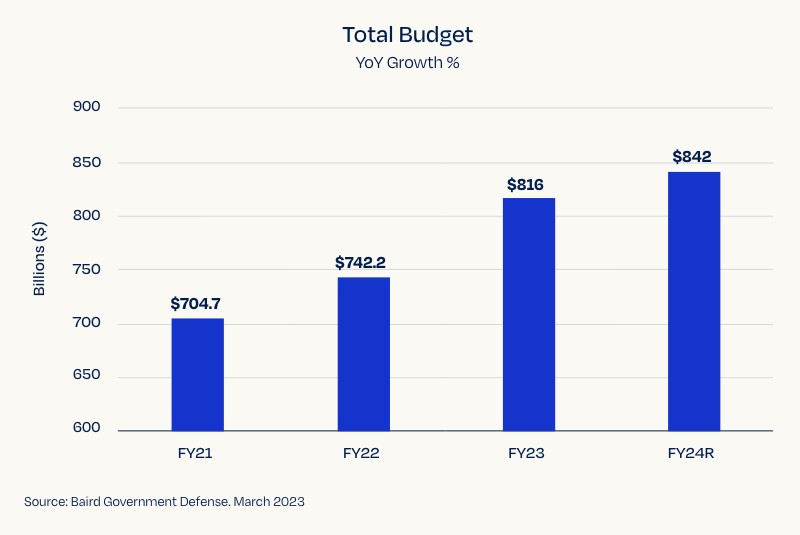
By design, federal contracting is a market designed to create commodity.
The government doesn’t want a single bidder for any services, nor does it explicitly want to disadvantage any competitor. (At least, this is the way the system is designed). As a result, procurements are much longer and more transparent than B2B. Federal contractors all respond to the same RFPs, work with the same labor categories, same general pricing targets and promise to deliver against the same statement of objectives. Contractors talk to the same small handful of people that sit on the evaluation board and we repeat all the post-contact factors.
And this is where marketing matters most. When you get squeezed into commodity and differentiation is all but impossible, distinction matters.
Marketing Is Your Biggest Opportunity Stand Out
“You may have any attributes you like,” the famously rigid Henry Ford might’ve quipped if he marketed contractors rather than made cars, “so long as it’s innovation, partnership, and commitment to mission.”
Because contractor marketing is often so insular and customer-following, we recite the bromides of the government. Innovation is important. Partnership. Mission above all. These are category factors. Things true of everyone in your category. After all, have you ever seen a company position as proud Luddites, terrible partners or only driven by the SOW?
So, no matter how much you spend, all you’re doing is telling the market and your own company that you’re just another contractor.
But in marketing, you can be distinct.
The big tagline. The great brand name. The incredible brand promise. The forward design makes you stand out from the sea of templated design. The customer-focus on what you enable them to do, not the recitation of your biography of more than X years.
In marketing, federal contractors can be distinct, the live musician in a sea of elevator music, even though they’re not differentiated on capability.
Marketing Means You Start Ahead
Because the first question the evaluation board ponders when a prop is reviewed shouldn’t be ‘who?’
Marketing builds an identity, and a feel for your business. If you do it right, it makes you seem larger than you are. It makes you distinct, so your prop gets read with a positive feeling of your company, not the prove-it-to-me approach to an unknown bidder.
At least at the current time, evaluation boards are people, not AI. People can be influenced. The small handful of people who will decide awards may control millions or billions, but they’re influenced into buying major programs just as they are peanut butter. Evaluators, like everyone else, are comfortable with the brands they know. Building that relationship starts with building your brand. (And of course, if your marketing is focused on the RFP, you’re already behind the curve. We’ll get further into how to align your marketing to your pipeline and how to influence perception well to the left of the RFP later).
Be the company they want to award, not the company they have to be talked into.
It Creates an Identity for Your Company
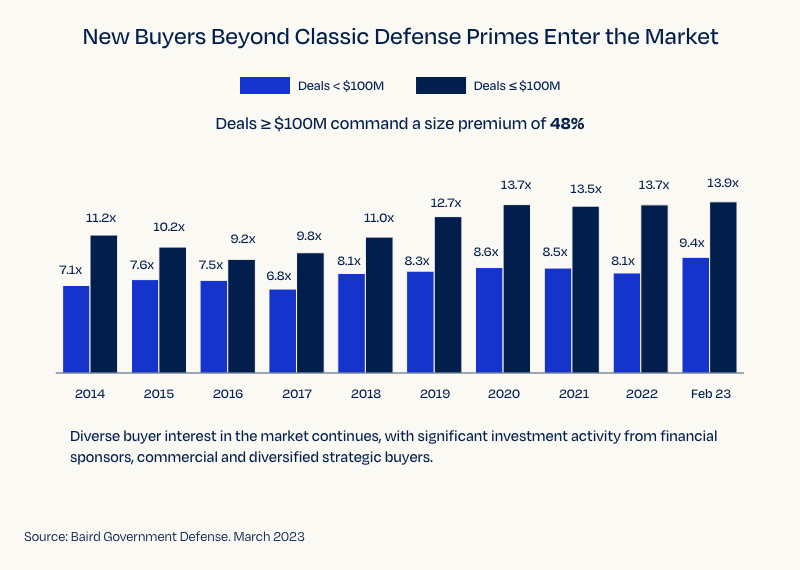
It’s not just the government that pays attention to your marketing.
It’s potential investors, too.
Marketing is the most important expression of how you want your company to be perceived. No one will ever consider your company more exciting and impressive than you do. Your marketing should set the highest bounds of how you want to be thought of.
It’s not just for your customers and your teammates. It’s your current and future employees, those invaluable assets that actually do the work for federal contractors. The same ones you are unlikely to be able to pay much more than anyone else bidding for the experience and qualifications, due to the commoditization of labor in federal contracting. Offer them an opportunity to work in something that’s meaningful in a way that doesn’t sound like everyone else. (And if the phrase, “It’s more than a job, it’s a career,” appears on your website, please stop what you’re doing, delete it, and then return.)
It becomes a clear statement of who you are, what you’re trying to achieve, and how they’ll play a part in incredibly big stories. Most employees, particularly those that want to support the government, want to be a small part of a small story. Marketing is where the big story gets defined.
Because in a sea of sameness and industry lifers, the ability to be distinct is the single greatest opportunity any contractor has.
“Baird’s Government & Defense team is a leading M&A advisor to the sector. Since 2018, we closed 64 transactions totaling over 23 billion in value. ”
About BluetextBluetext provides integrated communications services designed to help clients connect with key audiences, reach new communities, enhance their brand and protect their reputation. With deep expertise leveraging many diverse marketing strategies, we utilize every channel to attack the most critical challenges facing our clients. From repairing damaged reputations to connecting with key government decision-makers to driving product demand, our clients know that the team at Bluetext will help them achieve their goals with measurable results every step of the way. |
About BairdBaird is a leading global investment bank with more than 400 banking professionals in the U.S., Europe and Asia. We provide corporations, entrepreneurs, private equity and venture capital firms with in-depth market knowledge and extensive experience in merger and acquisition, restructuring, debt advisory and equity financing transactions. Committed to being a great workplace, Baird ranked No. 23 on the 2023 Fortune 100 Best Companies to Work For® list – its 20th consecutive year on the list. For more information, please visit Baird’s website at www.rwbaird.com.
|
If any industry vertical is a prime opportunity for metrics-driven PR, it’s the public sector. Government agencies are a massive opportunity for technology and other companies that can help supply the products, services, and solutions that agencies need on a daily basis. Yet, many brands struggle with how to market to the public sector, especially at the Federal level. How purchasing decisions are made, the way agencies issue contracts and the buying cycles they follow are much different than the commercial sector.
More importantly, the messages that resonate with Federal executives are different. Return on investment, a key marker in the commercial world, isn’t as much of a factor in the public sector. Agencies have fixed budgets; and while they have downward budget pressures, they don’t have to answer to investors or the stock market. Instead, they focus on mission requirements, staying within budget parameters, and meeting legislative and policy mandates. They are risk-averse and look for solutions that will enable them to accomplish their goals without jeopardizing their own careers.
For these reasons, it takes a different approach to public relations to execute an effective campaign that will reach, educate, and motivate government buyers. There are fewer media outlets that cover the vertical, and fewer reporters available as the size of the publications have shrunk. Because of this demanding market, metrics-driven pr in the public sector is essential for implementing a successful media relations program.
One of our clients that has the public sector as one of its key target markets is Cloudera, an industry leader in open-source Hadoop big data solutions for enterprise organizations to leverage the intelligence in their systems. When Cloudera wanted to expand its presence in the Federal market, it turned to Bluetext to design and execute an effective metrics-driven public relations program.
Some of the key elements of the program, in addition to plain old-fashioned nuts and bolts media relations, was to “Federalize” Cloudera’s messages and news. This included:
- Identifying customer advocates early in their relationship to secure customers that would share their results with Cloudera for media relations purpose;
- Identifying Cloudera-specific messages and differentiated angles on news topics;
- Streamlining the pitch review cycle, especially for rapid response; and
- Enlarging the spokesperson bench to establish early on the topics and areas of expertise that each expert could talk to.The results of this program have proven the point that when a sophisticated program is linked to metrics, it has the best chance of achieving the program goals.
Here are some of the results of the program over the previous 12 months:
- 39 stories, surpassing the target goal
- 18 target publications hit, including American City & County, FCW, MeriTalk, The Hill, Federal News Radio, and NextGov
- 7 bylines placed in NASCIO, FCW, GovLoop, American City & County, SIGNAL, Fifth Domain
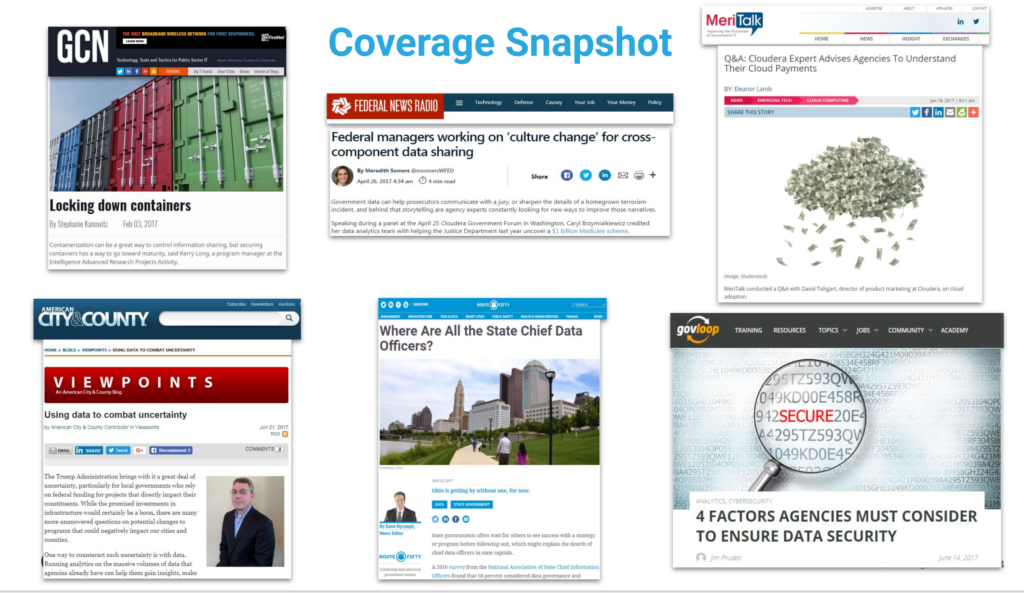
More importantly, we were able to garner a more than 44 percent Share of Voice in the market against Cloudera’s main competitors.
